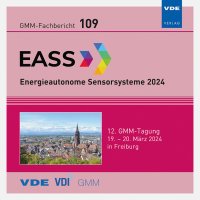Temperature enhanced Lithium-Ion-Batteries for Small-Scale Sensor Systems
Konferenz: EASS – Energieautonome Sensorsysteme 2024 - 12. GMM-Tagung
19.03.2024-20.03.2024 in Freiburg, Germany
Tagungsband: GMM-Fb. 109: EASS 2024
Seiten: 3Sprache: EnglischTyp: PDF
Autoren:
Hauser, Florian; Margueron, Samuel; Schecker, Olivier
Inhalt:
The limited installation space of small-scale sensor systems requires the dimensions of installed components to be reduced. In the case of energy storage devices such as capacitors or batteries, this reduction in volume has a direct effect on the amount of energy that can be stored. By integrating batteries into substrates or sensor housings, these can be expanded to include the property of energy storage and thus lead to a more efficient utilization of the space. Due to the instability of the cell chemistry at temperatures above 80 °C, conventional lithium-ion batteries cannot withstand the demands placed on batteries during the manufacture of such sensor systems - especially when used as printed circuit boards. This work deals with lithium-ion batteries whose thermal resistance enables integration into structural elements of space-constrained sensor systems. In particular, it deals with the construction of lithium iron phosphate (LFP) graphite batteries with an electrolyte of lithium bis(oxalato)borate (LiBOB) in γ-butyrolactone (GBL) and ethylene carbonate (EC), as well as the behaviour with regard to thermal loads at temperatures between 200 °C and 220 °C. The electrochemical characterization of the cell was carried out using galvanostatic measurements. The effects of heating the cells were investigated by comparing thermally stressed cells with unstressed cells of identical design. The cell tem-perature was measured inside the battery housing in the immediate vicinity of the cell stack. This ensures that the electrodes and electrolyte were exposed to the specified thermal loads. It was found that the batteries tested continued to function even after thermal stress and were therefore suitable in principle for integration into structural elements.


